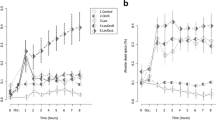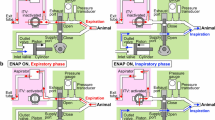Summary
The significance of pulmonary pressure-flow relation and its correlation to alveolar dead space and histological lesions of the lung were evaluated in ten mongrel dogs, which were subjected to standardized bone trauma and hemorrhagic hypotension at 40 mm Hg for 3 h. These results were compared with those of 5 control dogs without trauma and shock.
Two different pressure-flow curves were obtained by consecutive measurements of cardiac output and mean pulmonary artery pressure during stepwise arterial hemorrhage and reinfusion.
In each experiment, the difference between the two curves at CO of 100 ml/kg min was obtained and represents an increase in pulmonary artery pressure (Δ MPP). This increase in pulmonary artery pressure is flow-independent and, therefore, can be used as a quantitative indicator of pulmonary vasoconstriction or vascular obstruction. Severity of shock (uptake) as well as grade of early histological lesions of the lung (microthrombi, edema, hemorrhage) and increased alveolar dead space after reinfusion were associated with a more pronounced shift of the pulmonary pressure-flow curve. In severe experimental shock, therefore, a consistent pattern of pulmonary hemodynamics, lung histology, and respiratory function was demonstrated by the pulmonary pressure-flow relation. This approach permits estimation of the effects of therapeutic interventions and may be suitable for assessing postshock pulmonary impairment.
Similar content being viewed by others
References
Bayly T, Clements JA, Osbahr AJ (1967) Pulmonary and circulatory effects of fibrinopeptides. Circ Res 21:469–485
Buckberg GD, Lipman CA, Hahn JA, Smith MJ, Hennessen JA (1970) Pulmonary changes following hemorrhagic shock and resuscitation in baboons. J Thorac Cardiovasc Surg 59:450–460
Cook WA,Webb WR (1968) Pulmonary changes in hemorrhagic shock. Surgery 64:85–94
Finley TN, Lenfant C, Haab P, Piiper J, Rahn H (1960) Venous admixture in the pulmonary circulation of anesthetized dogs. J Appl Physiol 15:418–424
Garvey JW, Hagstrom JWC, Veith FJ (1975) Pathologic pulmonary changes in hemorrhagic shock. Ann Surg 181:870–875
Gerst PH, Rattenborg C, Holaday DA (1959) The effect of hemorrhage on pulmonary circulation and respiratory gas exchange. J Clin Invest 38:524–538
Godal HC, Abilgaard U (1966) Gelation of soluble fibrin in plasma by ethanol. Scand J Haematol 3:342–350
Jesch F, Klövekorn WP, Sunder-Plassmann L, Meßmer K (1972) Die Bedeutung des uptake im experimentellen hämorrhagischen Schock. Res Exp Med (Berl) 157:267–269
Jesch F, Sunder-Plassmann L, Meßmer K (1973) Die Bedeutung des uptake im experimentellen hämorrhagischen Schock. Res Exp Med (Berl) 159:141–151
Klöss T, van Deyk K, Junger H (1983) Pulmonale Druck-Fluß-Beziehung bei respiratorischer Insuffizienz nach hypovolämisch-traumatischem Schock. Hefte Unfallheilkd 156:101–106
Leinberger H, Bleyl U, Brückner UB, Klöss T, Metzker M, Saggau W, Schmier J (1980) Hämodynamik, Histologie und Funktion der Lunge nach akutem traumatisch-hämorrhagischem Schock. Beeinflussung durch Methylprednisolon und Acetylsalizylsäure und Dipyridamol. In: Brückner JB (Hrsg) Kreislaufschock, Anaesthesiologie und Intensivmedizin, Bd 125. Springer, Berlin Heidelberg New York, S 27–32
Leinberger H, Brückner UB, Metzker M, Ulmer HE, Saggau WW, Schmier J (1974) Pulmonale Mikroembolie: Pathogenetische Bedeutung von Veränderungen der Blutgerinnung und der pulmonalen Hämodynamik nach Trauma und Blutentzug. In: Mandl W, Hartl H (Hrsg) Kongreßbericht der Österreichischen Gesellschaft für Chirurgie, 15. Tagung, Linz
Lessing AJP (1973) The lung in trauma. S Afr Med J 47:771–773
Luterman A, Manwaring D, Curreri PW (1977) Role of fibrinogen degradation products in the pathogenesis of the respiratory distress syndrome. Surgery 82:703–714
McKay PA, Burgess JH, Finlayson MH, Hampson LG (1969) Hypoxemia and atelectasis in experimental hemorrhagic shock: its decrease by periodic hyperinflation of the lungs. Can J Surg 12:351–358
Manwaring D, Curreri PW (1983) Platelet and neutrophil sequestration after fragment D induced respiratory distress. Circ Shock 9:75–83
Maseri A, Caldini P, Harward P, Joshi RC, Permut S, Zierler KL (1972) Determinants of pulmonary vascular volume: recruitment versus distensibility. Circ Res 31:218–227
Meyers IR, Meyer SS, Bual AE (1973) Does hemorrhagic shock damage the lung? J Trauma 13:509–519
Mittermayer C, Ostendorf P, Riede UN (1977) Pathologisch-anatomische Untersuchungen bei der respiratorischen Insuffizienz durch Schock. I. Lichtmikroskopische und biochemische Analyse. Intensivmed 14:252–262
Naimark A, Dugard A, Rango RE (1968) Regional pulmonary blood flow and gas exchange in hemorrhagic shock. J Appl Physiol 25:301–309
Rådegran K, Bergentz SE, Lewis DH, Ljungquist U, Olsson P (1971) Pulmonary effects of induced platelet aggregation. Intravascular obstruction or vasoconstriction. Scand J Clin Lab Invest 28:423–427
Ratnoff OD, Menzie C (1951) A new method for the determination of fibrinogen in small samples of plasma. J Lab Clin Med 37:316–320
Saggau WW, Ulmer HE, Bleyl U (1975) Changes of coagulation and fat metabolism following pulmonary microembolism after trauma and hemorrhage. Thromb Diath Haemorrh 33:477–492
Silberschmid M, Szczepanski KP, Lund C (1975) Hemorrhagic shock in dogs without major pulmonary changes. Eur Surg Res 7:10–22
Tiffenbrun J, Shoemaker WC (1971) Sequential changes in pulmonary blood flow distribution in hemorrhagic shock. Ann Surg 174:727–733
Wahrenbrock EA, Carrico CJ, Amudsen DA, Trummer MJ, Severinghaus JW (1970) Increased atelectasis pulmonary shunt during hemorrhagic shock in dogs. J Appl Physiol 79:615–621
Weissmann G, Smolen JE, Korchak HM (1980) Release of inflammatory mediators from stimulated neutrophils. N Engl J Med 303:27–34
West JB, Dollery CT (1965) Distribution of blood flow and the pressure-flow relations of the whole lung. J Appl Physiol 20:175–183
Wilson JW, Ratcliff NB, Mikat E, Hackel DB, Young WG, Graham TC (1971) Leucocyte changes in the pulmonary circulation. Chest [Suppl] 59:36–39
Zapol WM, Snider MT (1977) Pulmonary hypertension in severe acute respiratory failure. N Engl J Med 296:476–480
Author information
Authors and Affiliations
Additional information
This work is dedicated to Professor R. Schorer on his 60th birthday
Rights and permissions
About this article
Cite this article
Klöss, T., Brückner, U.B. & Leinberger, H. Pulmonary pressure-flow relation after trauma and hemorrhagic shock. Res. Exp. Med. 186, 325–336 (1986). https://doi.org/10.1007/BF01852098
Received:
Accepted:
Issue Date:
DOI: https://doi.org/10.1007/BF01852098




